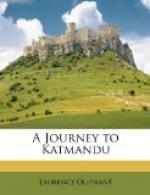The Raj Guru is the highest spiritual dignitary in Nepaul, and in that capacity received the greatest deference from every one, including Jung, whose popularity in some measure rests on his intimate relations with the chief priest, to whom he invariably paid every mark of respect. The Raj Guru met us at Benares, and granted indulgences to those who had visited England. So great is the respect shown him, that upon entering his presence the prime minister invariably touched with his forehead the foot of the holy man. To the office of spiritual adviser to the Rajah is added that of judge of the spiritual court, which is one of great emolument, arising chiefly from fines levied on the infraction of religious ceremonies or ordinances—such as the killing or maltreating of a cow and other like enormities.
Next in order follow the Kazies, or “Patres conscripti,” who ought to possess some voice in the administration of affairs, but are content to remain silent during the independent rule of the Minister Sahib. They number thirty or forty, and their duty is to consult upon all weighty matters connected with the Government, while some act as governors of provinces, others as judges in important causes.
Then come the Sirdars, who also decide causes, and possess considerable authority in the more remote districts, governing some of the provinces, and superintending the collection of revenue. Their number is far larger than that of the Kazies.
We visited the supreme court one day and saw the Chief-justice, or Durma Dikar, sitting cross-legged (smoking his hookah on the verandah), the court having adjourned. The old man bore that venerable appearance which is everywhere esteemed inseparable from the judicial character, and I doubted whether his long grey beard was not a more imposing, as it certainly was a more natural and graceful, appendage than a wig.
There are six law courts in Katmandu, presided over by Sirdars and Bicharees, and the laws and modes of punishment are very effectual for the prevention of crime; for although a prisoner cannot be convicted except upon his own confession, he may be subjected to an ordeal which will most probably extort it; and, perhaps, in an eastern country justice is more effectually administered by such methods than where the judge decides on the guilt or innocence of a man by speculating on the character of the witnesses, and believing those who look most as if they were telling the truth; and where, although he knows that all the witnesses are more or less bribed, he is not allowed to take any but a voluntary admission from the prisoner, when perhaps a little gentle persuasion would save a great deal of unnecessary trouble, to say nothing of the amount of lying that might thus be dispensed with. Whatever the laws may be, they seem to give perfect satisfaction to the inhabitants, who cannot be called a litigious race.




